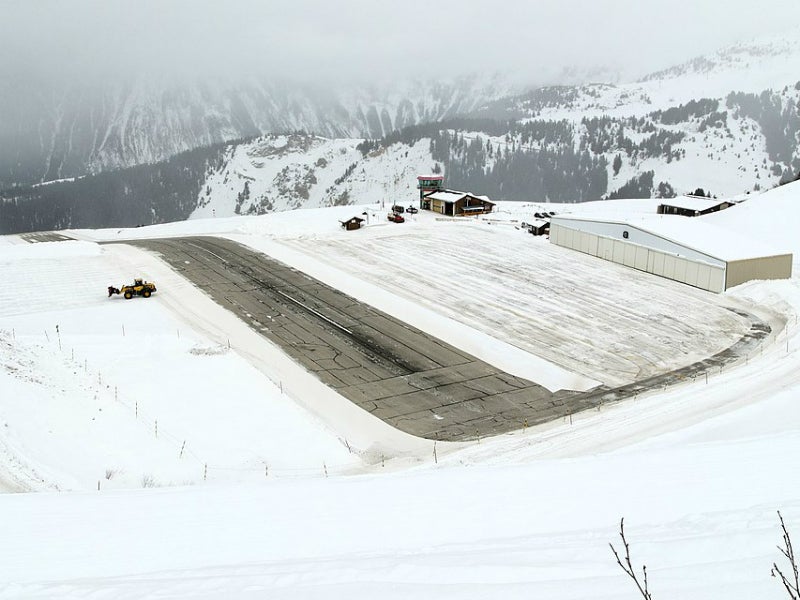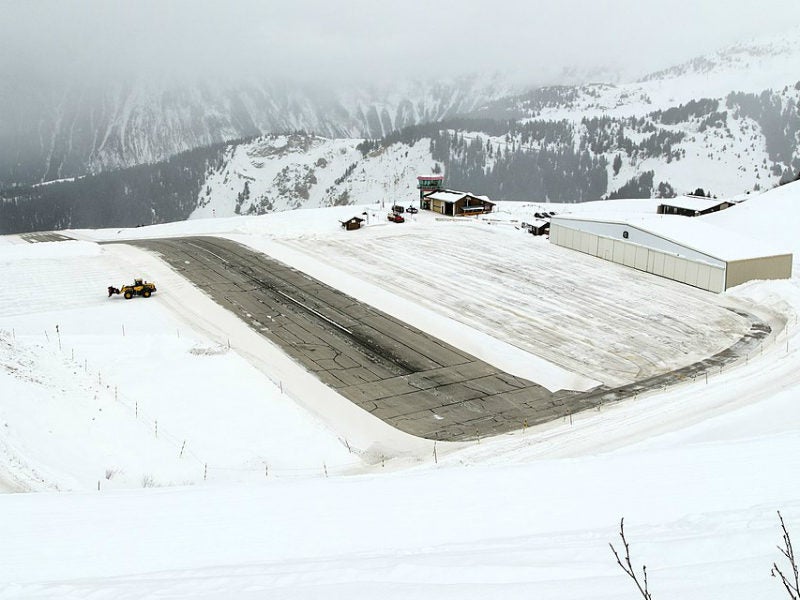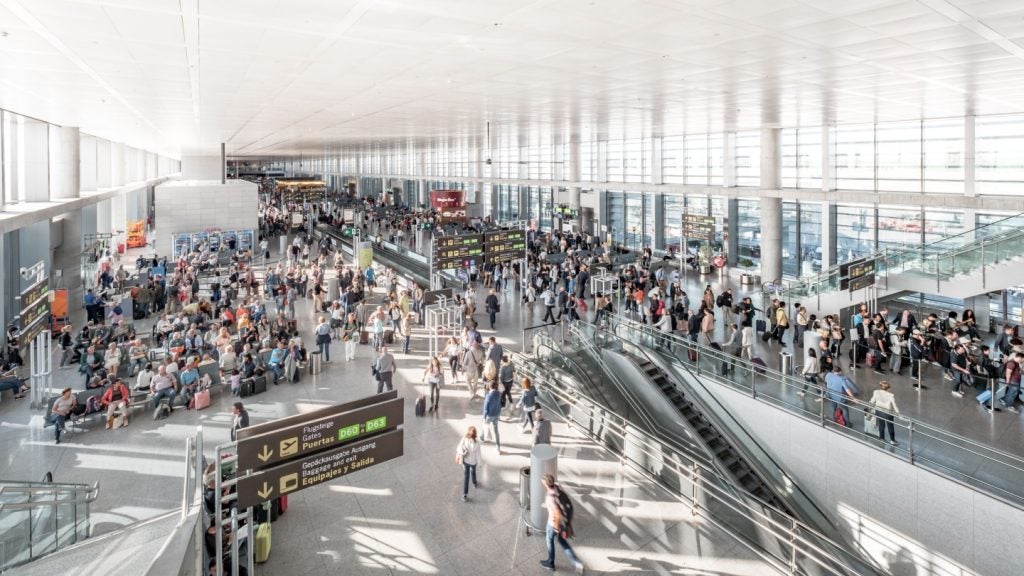
Juancho E Yrausquin Airport, Saba
Located on the Dutch Caribbean island of Saba, Juancho E Yrausquin Airport has the shortest runway in the world available for commercial use. It is 1,312ft long and only allows regional propeller aircraft flights provided by Winair from nearby islands.
The runway has three cliff edges over the sea, with the fourth side enclosed by high hills. Services began operating mid-1962 following support from politicians, including the Netherlands Antilles Minister of Finance Juancho Yrausquin, who the airport is named after.
The first flight to land at the airport was in 1959 when aviation pioneer Rémy de Haenen flew to the cleared site following its selection. Most of the island’s population watched the landing.
In 1998, the airport’s terminal building was destroyed by Hurricane Georges. The Dutch Government provided funding to construct the new building and it was dedicated to de Haenen.
Barbuda Codrington Airport on the nearby island of Barbuda features a 1,640ft-long runway. The airport was destroyed in September 2017 from Hurricane Irma and was closed as the island was evacuated.
Heligoland Airport, Germany
Heligoland Airport is located on the German island of Düne, approximately 70km from the mainland in the North Sea. Its runway is 1,575ft long, having been extended in 2006 from 1,312ft in order to meet EU regulations for commercial air traffic.
How well do you really know your competitors?
Access the most comprehensive Company Profiles on the market, powered by GlobalData. Save hours of research. Gain competitive edge.

Thank you!
Your download email will arrive shortly
Not ready to buy yet? Download a free sample
We are confident about the unique quality of our Company Profiles. However, we want you to make the most beneficial decision for your business, so we offer a free sample that you can download by submitting the below form
By GlobalDataRegular flights are operated by regional airline OFD Ostfriesischer-Flug-Dienst to Heide-Büsum Airport and Sea-Airport Cuxhaven / Nordholz in northern Germany. Heide-Büsum Airport is in the German state of Schleswig-Holstein, and features a short runway that measures 2,362ft.
To access the main Heligoland island, visitors can use a ferryboat from the port on the other side of Düne, which is accessed by a single taxi service.
The airport served as a military field during the Second World War. Having been destroyed by enemy attacks, it was later rebuilt in 1962.
In 1973, a Lufthansa pilot is said to have briefly touched down on Heligoland Airport’s runway in an empty Boeing 737 aircraft, followed by an immediate take-off. He was reportedly fired after this incident.
Tenzing-Hillary Airport, Nepal
A popular starting point for those climbing Mount Everest, Tenzing-Hillary Airport has a 1,729ft-long runway with a large drop at the south end into the valley below. Despite its small size, the airport handled 119,801 passengers in 2017.
It is known as one of the most dangerous airports in the world due to the runway’s length and position, with only helicopters and small fixed-wing aircraft operating services. It is 2,774m above sea level, making it the 37th highest airport in the world.
Landing at the airport is made more difficult by the lack of navigational landing guides, which limits the site to daytime operations usually between 6am and 9am.
There are high standards for pilots operating services to the airport as the Civil Aviation Authority of Nepal requires a minimum of 100 short take-off and landing flights with one year of experience in Nepal, as well as ten flights into the airport accompanied by a certified instructor.
The airport was built in 1964 by Edmund Hillary, who was one of the first mountaineers to reach the summit of Mount Everest with his companion, Tenzing Norgay, 11 years earlier. Hillary bought one of the only available plots of land for the airport. To make the ground of the runway smooth and flat, he asked local Sherpas to perform a foot-stomping dance in exchange for liquor. The runway was only paved in 2001.

Courchevel Airport, France
Serving the ski resort in the French Alps, Courchevel Airport has a 1,762ft-long runway and is mainly used by helicopters, as well as small fixed-wing aircraft. The runway is on a mountain at an elevation of 2,008m and has an 18.6% gradient with no lighting aids, making landing difficult.
The runway was originally 1,230ft long but was extended to its current size for the 1992 Winter Olympics. Its width was doubled from 40m to 80m.
The French Civil Aviation Authority (DGAC) has set regulations on flights to Courchevel. Currently, the only airline allowed to operate commercial charter flights is Alpine Airlines. DGAC only permitted commercial passenger flights to the airport in 2015. Other limitations include no go-around procedures due to its surroundings and the lack of instrument approach procedure.
John A Osborne Airport, Montserrat
John A Osborne Airport is on the British Overseas Territory island of Montserrat in the Caribbean Sea. The airport was built in July 2005 and features a 1,814ft-long runway. A public road runs underneath the short runway through a tunnel.
It replaced WH Bramble Airport located on the east coast of the island. The former airport was destroyed by the Soufriere Hills volcano eruption in 1997 along with most of the southern half of Montserrat, which has been designated as an exclusion zone, including its capital Plymouth. The island was only accessible by helicopter and ship between 1997 and 2005 before John A Osborne Airport was constructed.
Headquartered at the airport, FlyMontserrat operates regular services to Antigua, along with a range of charter flights to other Caribbean destinations. Other airlines are ABM Air, flying to Antigua, as well as Trans Anguilla Airways, operating charter flights to Anguilla.
Its name was changed from Bramble’s Airport in July 2008 in honour of Montserrat Chief Minister John Osborne.
Gustaf III Airport, Saint Barthélemy
Located in St Jean on the volcanic island of Saint Barthélemy, Gustaf III Airport has a 2,133ft runway. It is also known as Rémy de Haenen Airport or Saint Barthélemy Airport.
Aircraft approach the runway at a downward slope on the edge of a steep hill, ending on a short stretch of the beach, which is roped off advising people against sunbathing in the area. Aircraft get close to the roads surrounding the runway, as well as any tourists nearby.
The island is a popular tourist destination in winter, especially for celebrities. Small regional commercial and charter flights operate daily between other destinations in the Caribbean, including Antigua, Saint Martin, and Anguilla, with most carrying less than 20 passengers.
Princess Juliana International Airport in Saint Martin serves a transport hub for Gustaf III Airport, where passengers arriving on larger jetliners can transfer to smaller regional aircraft.
Barra Airport, Scotland
Barra Airport on the island of Barra, north of Scotland, is one of the only airports in the world to have runways on the beach. It has three runways marked with wooden poles in the sand, with the shortest measuring 2,231ft. The others span 2,621ft and 2,776ft.
Flights are scheduled during low tide, as the runways are covered when the tide rises. The only service from the island of Barra is operated by Loganair to Glasgow Airport, most commonly on Twin Otter aircraft. The beach is closed for public access when aircraft approach or take off from the runways, signalled with the flight sock. The air traffic control tower emits a strobe light as an additional warning.
The airport handles more than 10,000 passengers a year, with approximately 1,400 aircraft movements. Private flights operate at Barra Airport, with more than 60 private light aircraft landing every year.
Scottish operator Highlands and Islands Airports Ltd (HIAL) permits location filming on the beach runways, which have been featured in a number of films and documentaries.
Billy Bishop Toronto City Airport, Canada
Located on the Toronto Islands in Canada, Billy Bishop Toronto City Airport is a small airport serving the city centre of Toronto. It has two runways, with the shortest measuring 2,460ft, and a longer at 3,988ft.
The airport is accessible from the city through a pedestrian tunnel from Eireann Quay, as well as a regular ferry. The ferry journey is one of the shortest in the world, transporting pedestrians and cars across the river to the island in 90 seconds.
Billy Bishop Toronto City Airport was built in the late 1930s as the city’s main airport along with Toronto Pearson International Airport, which was intended to support its operations. Instead, Toronto Pearson became the main passenger airline hub, with Billy Bishop mainly serving small regional and general aviation flights.
A 50-year agreement between governments of Canada, City of Toronto and the Harbour Commission in 1983 banned jet aircraft operations at Billy Bishop Airport. Controversial plans proposed by Porter Airlines to expand the airport’s runways by 200m have been discussed by the airport’s operators and airlines with various government bodies since 2013 in order to accommodate Bombardier jet aircraft. However, they were ultimately called off with the government refusing to cancel the agreement.





